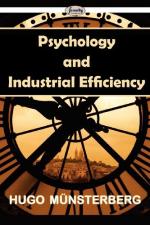Whoever has once schooled his eye to observe the limitless waste of human motions and psychophysical efforts in social life has really no difficulty in perceiving all this at every step. This ability to recognize possible savings of impulse may be brought to a certain virtuosity. Gilbreth, one of the leaders of the new movement, seems to be such a virtuoso. When he was in London, there was pointed out to him in the Japanese British Exhibition a young girl who worked so quickly that there at least he would find a rhythm of finger movement which could not any further be improved. In an exhibition booth the woman attached advertisement labels to boxes with phenomenal rapidity. Gilbreth watched her for a little while and found that she was able to manage 24 boxes in 40 seconds. Then he told the young girl that she was doing it wrongly, and that she ought to try a new way which he showed her. At the first attempt, she disposed of 24 boxes in 26 seconds and at the second trial in 20 seconds. She did not have to make more effort for it, but simply had fewer movements to make. If such economic gain can be secured with little exertion in the simplest processes, it cannot be surprising that in the case of more complex and more advanced technical work which involves highly skilled labor, a careful psychophysical study of motions must bring far-reaching economic improvements.
Yet the more important steps will have to be guided by special experimental investigations, and here the psychological laboratory must undertake the elaboration of the details. Only the systematic experiment can determine what impulses can be released at the least expense of energy and with the greatest exactitude of the motor effect. Investigations on the psychophysics of movement and the influences which lead toward making the movement too large or too small have played an important role in the psychological laboratories for several decades. It was recognized early that the mistakes which are made in reproducing a movement may spring from two different sources. They result partly from an erroneous perception or memory of the movement carried out, and partly from the inability to realize the movement intention. One series of investigations was accordingly devoted to the studies of those sensations and perceptions by which we become aware of the actual movement. Everything which accentuates these sensations must lead to an overestimation of the motion, and the outcome is that the movement is made too small. The concentration of attention, therefore, has the effect of reducing the actual motion, and the same influence must result from any resistance which is not recognized as such and hence is not subtracted in the judgment of the perceiver. Another series of researches was concerned with the inner attitude which causes a certain external movement effect and which may lead to an unintended amount of movement as soon as the weight to be lifted is erroneously




